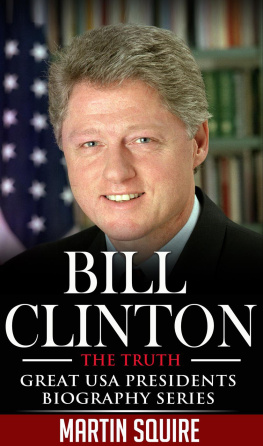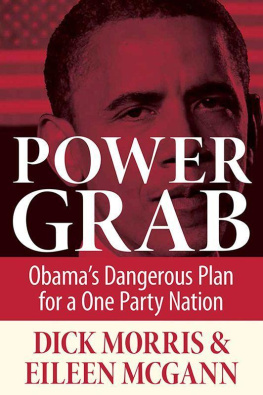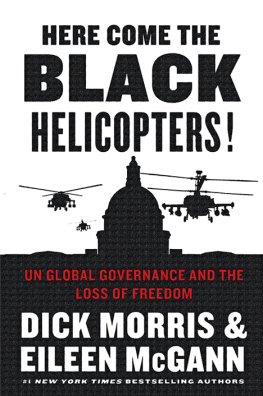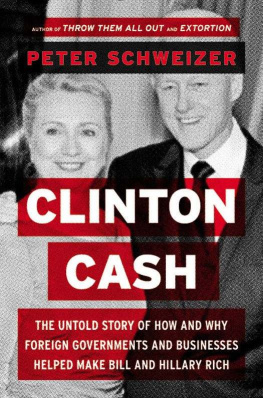Cracking the
Clinton Code
A riddle wrapped in a mystery inside an enigma: Sir Winston Churchills famous phrase has become familiar shorthand for almost anything we cannot easily understand. And in modern politics no figure embodies this phenomenon better than our forty-second president, William Jefferson Clinton. So much about him is still a puzzle. Even after eight years of watching his extraordinarily visible presidency and twelve years of listening to the endless scrutiny of his personality by pundits from every segment of the political spectrum, we still cant really say that we truly understand this complex, contradictory man.
Bill Clinton is a study in opposites. Consider the facts: He was one of the most popular and successful presidents in modern history. At the same time, he was disgraced by his transgressions in office, becoming only the second president to be impeached by the House of Representatives since the creation of our republic. As the first postmodern president, he was revered as a cultural icon by his supporters, while at the same time loathed and reviled by his opponents as illegitimate. His charisma, intellect, and charm are the core of his attractiveness, and captivate even the most skeptical observers. But his dark sidehis moodiness, temper, self-absorption, and lack of disciplineare unappealing and make him an easy target for his critics. Even reaction to the story of his life, as he has now told it in book form, has been widely split. When he appears on television to hype its publication, the ratings go through the roof. And yet, when reviewed in print, the book has been panned, even ridiculed. This polarity itselfin his personality and in his imageonly adds to his mystery and his celebrity. Whether they love him or hate him, the public wants to know all they can about him.
So curious are Americans about who Bill Clinton really is that his memoir, My Life, sold more than a million copies in its first weeks. In fact, among politicians, Clintons only serious rival in the nonfiction best-seller lists has been his equally opaque wife, Hillary Rodham Clinton, and her autobiography, Living History.
But the two memoirs are as different as Bill and Hillary themselves. In Living History, a thoroughly self-disciplined woman carefully masks who she really is. In My Life, a very complicated and sometimes dysfunctional man inadvertently and unwittingly reveals his actual characterat least to readers diligent enough to find him in its almost one thousand pages.
My Life is a metaphor for Bill Clinton himself. Like him, it is sometimes interesting, sometimes refreshingly open, sometimes fascinating. Just as often, however, it is incomplete, misleading, chaotic, overly detailed, superficial, and inconsistent. Still, hidden among the disorder is the remarkable story of who Bill Clinton is. And that story is very different from the one he tries to tell, and to sell. Despite the 957 pages he has exhaustively written about himself, the Bill Clinton in My Life, remains impenetrable, lurking somewhere behind the mind-numbing litany of trips, meetings, campaign stops, meals, and scandals. At first glance, his book seems to reveal little about his thinking, his motivations, or his emotions. He even manages to avoid telling us about the obvious pain and humiliation he must have suffered when he was impeached; instead he merely expresses contempt and rage.
Yet, once we begin judging the text of My Life against the available evidenceby piecing together what he says, what he doesnt say, what others have said, and what the public record shows actually happeneda clearer, more accurate picture of the man emerges. In fact, in order to find the real Bill Clinton within the pages of My Life, its important to understand what I think of as the Clinton Codecorrelating what Clinton says (or doesnt say) with other data and experience, and reconciling the obvious differences. Without that Code, we cannot grasp all of the former presidents assets and failings, his unique abilities, and his countervailing limitations, as they are exposed in the book.
As a twenty-year veteran of Bill Clintons campaigns and administrations, I have long and rich experience with his politics, his thinking, and his personality. For years I observed him at close range; I watched him think and act, make decisions, delay decisions, and avoid decisions. Eventually I grew confident that I understood his mind and motivations. And yet, despite all my experience with Clinton, not until I read My Life did I fully crack the Clinton Code. There, like a patient who has spent too long talking on his psychiatrists couch, Clinton provided the missing pieces that permitted mefor the first time since we met in 1977to understand this man fully.
Once decoded, despite its obvious omissions and limitations, My Life offers a guided tour through the labyrinths of the brilliant but cluttered, disorganized, and often raging mind of Bill Clinton. As a historical guide to the Clinton presidency, My Life is disappointing. There are no surprises, no nuances, and no compelling lessons. Page after page provide a diary-style summary of notable events, without any organized or logical theme. State dinners, foreign trips, and meetings with cabinet members are given the same weight as golf outings, appearances before the grand jury, and letters from children of friends. We learn what he ate for lunch every day in college, but not why he pardoned the drug dealer client of Hillarys brother. He describes in detail the floor plan of the small apartment he and Hillary shared in New Haven, but is silent about their solicitation of expensive Spode china, silver, and other gifts from donors while still in the White House. Did he really think readers would care that the bedroom in New Haven was between the dining room and the kitchen? Did he think we wouldnt notice his decision to ignore the gift fiasco?
For centuries, Egyptian hieroglyphics remained mere inscrutable markings to scholars and archaeologistsuntil finally a soldier in Napoleons army happened upon the Rosetta stone, where the same text was written in hieroglyphics, Egyptian, and Greek. Comparing the three texts allowed scholars to decode the hieroglyphics and make them comprehensible for all to read. Deciphering My Life is a similar exercise in cryptography. Just as the translation of the Rosetta stone led to an understanding of the history and culture of the ancient Egyptians, the unraveling well undertake here offers a new way of looking at and comprehending the convoluted world of Bill Clinton. By comparing Clintons version of reality with what actually happened, well be able to understand not only the gaps and errors in his accountbut the broader reasons behind the disparity.










